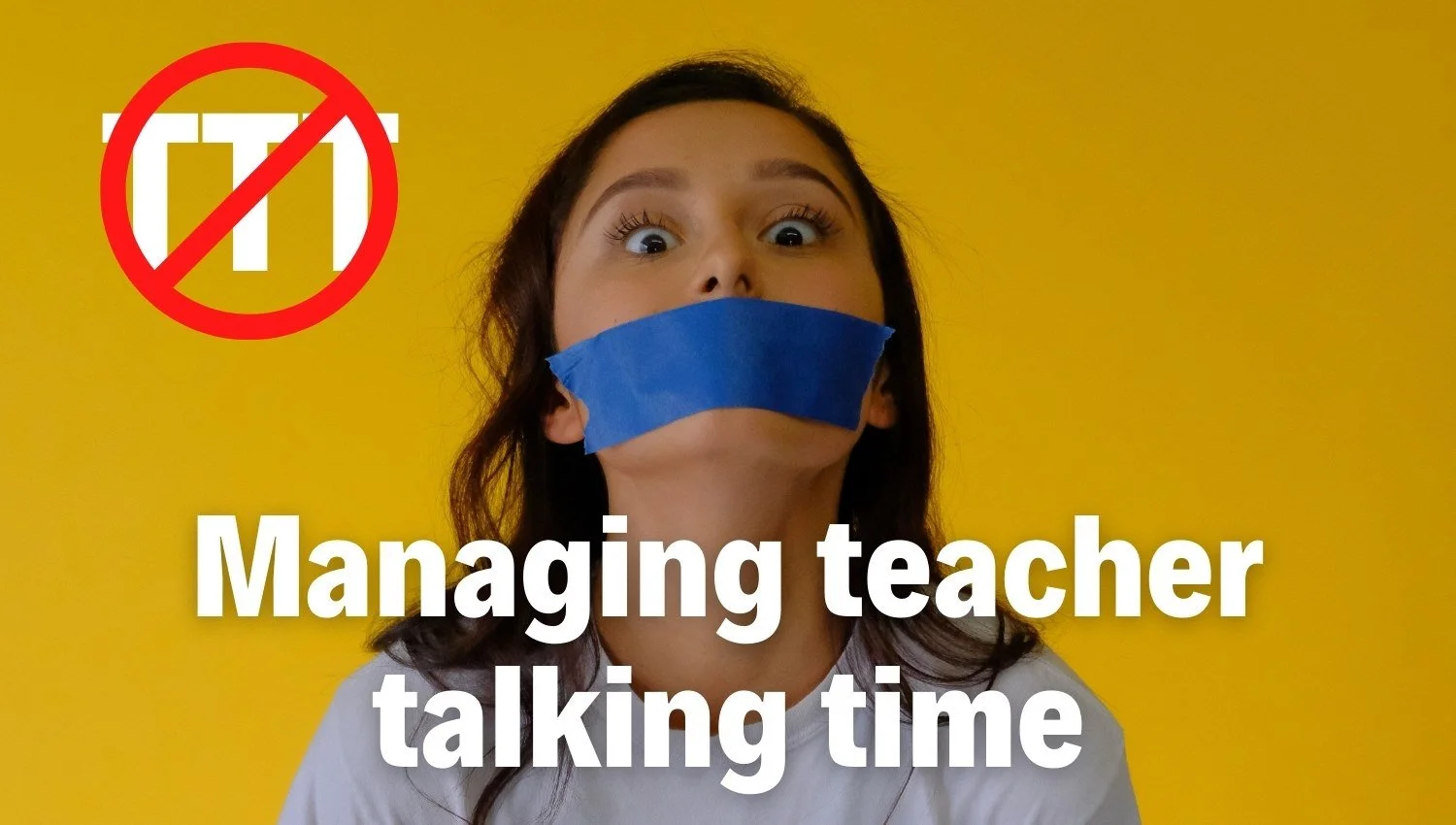One of the big factors teachers need to consider is managing teacher talking time, commonly known as TTT. Here are some ideas to limit our teacher talking time and increase student talking time.
Managing teacher talking time (TTT)
As an English teacher, our main responsibility is to teach, but we often find there are a lot of classes and we are easily burn out, especially with our throat. I myself suffer from the sore throat a lot after the busy weekend. Part of the reason is maybe because we are talking too much in the classroom, which we don’t have to do. Managing our talking time, not only gives more speaking opportunities to students, but also can reduce our fatigue.
Teacher talking time is important, but should be reduced
Teacher Talking Time, which is also known as ‘TTT’, is a very important part of our lesson delivery. A lot of academic trainers or managers take it into consideration when evaluating teachers’ classroom performance. We have been constantly told that we should reduce our TTT and increase STT in the classroom. However, Teacher Talking Time is not necessarily a negative thing, and we still need it. TTT is discussed in the Classroom Management unit of the excellent 180-Hour Higher Certificate in TESOL, which I just completed.
Demonstrating language and giving instructions through talking
As a teacher, we need to demonstrate the language, facilitate, and give instructions by talking. At the beginning, we need to greet the students, and we might need to ask some questions or tell a story to set the context or just to get students’ attention. During the study time, we need to explain the content, or need to check students’ understanding by asking CCQs. And we might also need to practice the language with students by joining the role-play, or dialogues, etc. Therefore, Teacher Talking Time is necessary, and we cannot avoid it.
Give students the talking time
However, if we talk too much, there are some disadvantages. First of all, we end up exhausting our throat like I mention from the beginning, especially during the weekend or peak seasons. Second, we might dominate the class and cannot give enough time to students to practice language. Students will have lower motivation and autonomy. Besides, if we are teaching beginners or young learners, who do not have really solid language foundation, they might feel confused when we talk too much and especially with complex language. We will end up explaining it again and waste time in class. Students will lose focus and may have some behavioral problems too.
That being said, Teacher Talking Time is important in the class, but we still need to improve Student Talking Time in class. This is all part of managing teacher talking time well.
Setting strict teacher talking time rules is’t always realistic
Some argue that the less TTT the better – some teachers even try body language or gesture to replace most verbal language in their lessons; Others set a strict percentage of TTT and STT to evaluate the quality of the lessons – but it’s quite unrealistic to calculate the portion, isn’t it? In my opinion, it’s not like we talk less, the students will talk more. We still need teacher talk to explain, question, and facilitate in class. Miming is not the best idea. Generally speaking, if the student talking time are much more than teacher talking time, then we can consider it as a successful lesson.
How can we manage teacher talking time?
Based on my previous learning and my own experience, here are a few things we can do to manage Teacher Talking Time and increase Student Talking Time:
Make your instructions clear and concise. Unit 5 of the TEFL Lemon Higher Certificate in TESOL covers giving sound classroom instructions. When giving instructions, make sure the language you use is appropriate to students’ level so that they are able to understand, otherwise you will end up spending extra time explaining it again. Make it straightforward and cut the unnecessary so that it will be clearer.
Use elicitation rather than explanation. When presenting new language, we can show examples and ask questions to elicit answers from students rather than tell them directly. By doing this, we don’t need to spend a lot of time explaining, and in the meanwhile, we can check their understanding. Students will be more engaged, too – because they are not just ‘accepting’ the knowledge.
Replace TTT with non-verbal cues
Use body language, gesture, facial expression, and mime rather than words. Non-verbal language conveys as much information as words do. In the class, we can use some non-verbal language to replace some words so that we can reduce our teacher talking time.
Encourage peer feedback instead of teacher feedback. During class activities, we usually give some feedback to students or correct their mistakes by explaining it again. Why don’t we get other students to do it? We can encourage stronger students to give feedback to other students so that we can reduce our talking time. Also, we can challenge stronger students so that they won’t feel bored. It’s a good way to develop learner autonomy too.
A lot of teacher talking time is often just unnecessary echoing
Avoid Echoing. A lot of teachers like to repeat what students say in the classroom. For example, you ask, ‘What is it?’ and students respond, ‘It’s an apple’. Then you probably would say ‘right, it’s an apple’. Sometimes I find myself doing that too. It’s really hard to control and it’s totally unnecessary talking in the class. To improve this, I think we can take some recording during our lessons to see whether we echo and how often we do it. By listening to our own language, it’s easier for us to identify the problem. Then next time when we are teaching, we should be aware of echoing and try not to do it that often.
TTT: silence is golden
Tolerate Silence. A lot of teachers believe that there should be a lot of ‘noise’ going on in a good class. That’s what I have been told to. It stands if we are evaluating a speaking-focus lesson, but students need to think and process information if it’s a reading or writing lesson. We often feel nervous when students are silent because we might think they are not engaged, lost focus, or anything. And some teachers will start to explain the content again and say something else just to avoid the ‘peace’. But it’s not necessary. Students are silent sometimes because they need time to think. We should learn to cope with the short silence and give enough time to students to think before they respond.
Learning how to manage Teacher Talking Time is long journey. Let’s just keep practicing.
by Jialong Yang

